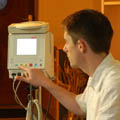COPD in Carlisle
- 16 March 2006
 Wendy McLellan
Wendy McLellan
Business Development Manager for Health, Tunstall
According to the National COPD Audit (2004), the cost to the NHS of treating Chronic Obstructive Pulmonary Disease is £818million per annum. There are on average 1,000 hospital admissions and 25,000 primary care consultations in a typical trust area, and over 30% of emergency admissions are re-admitted to hospital within 90 days.
This clearly places an enormous burden on the NHS, both economically and also in terms of primary and secondary care provision, with extended hospital stays and bed-blocking placing a strain on resources.
But while the cost to the NHS is high, the effect of COPD on individuals – characterised by difficulty breathing and slow and forced emptying of the lungs – is more dramatic, with marked impairment of quality of life in many cases.
In severe cases of COPD, patients are totally reliant on oxygen to even walk or talk and can be wheelchair-bound for a large proportion of the time. Constant visits to the hospital for check-ups can be stressful for the patient and eat away at valuable NHS resources.
With this in mind, the Department of Health has put forward new models of care which will fit care to the needs of the patient, while simultaneously reducing some of the burden on the NHS.
As part of the Government’s patient-focused New NHS, NICE guidelines (2004) have been put in place to deliver more care at a community level, aimed at managing patients with chronic respiratory diseases such as COPD in their own home.
Research has shown that early supported discharge offers good clinical outcomes and is as safe as continued hospitalisation. It does not need to be consultant-led – reducing the burden on primary care resources – and has a high level of patient acceptance, as patients welcome the increased independence and reassurance of familiar surroundings.
Carlisle’s example
A healthcare project launched by Carlisle Housing Association, Carlisle PCT and Tunstall has supported the early discharge of patients with COPD.
Carlisle Housing Association approached the PCT in 2002 to develop a plan of care that would support early discharge of patients who had been admitted with COPD. The project was extended, and proved so successful that the service has now become a mainstream element of care provision for COPD patients.
Before a person is discharged, all the necessary clinical information, instructions and escalation process are inputted into the patient’s monitoring plan by the nurse, using a web browser over an intranet connection.
Patients just home from hospital and their carers are trained on how to use the S21 monitoring unit to monitor their condition. Then, twice a day, they take their own measurements, including temperature, pulse, blood oxygen levels, heart and breathing rates, ECG and non-invasive blood pressure.
The telemedicine monitor records the results and sends them over the phone line to a secure server where they are stored as an electronic patient record in a database accessible by the clinician, community matron or project nurse.
If the monitor detects any abnormalities or deviations from the set parameters for the patient’s results during the vital signs monitoring period, for example blood pressure beginning to drop, it automatically puts a call through to the response centre, where a trained operator will then contact the patient’s nurse.
Proactive management
This kind of technology has enabled healthcare professionals to manage COPD more proactively and to support patients in their own homes. Home monitoring enables carers to make early diagnoses and more timely interventions, helping to prevent deterioration in a patient’s condition and thus reduce the need for hospital stays, GP visits and medication.
One patient in Carlisle commented: “Having my COPD monitored at home means that I am able to get help if it is required, this offers me and my husband the much needed support and reassurance after a hospital stay.”
A clinical evaluation published in 2005 by Carlisle Housing Association showed that so far, the system has seen almost 1,000 bed days saved to date, with average stays reduced by almost 50% from 10 to 5.5 days. This has saved the Trust valuable budget and resources, as well as increasing the Trust’s capacity.
Telemedicine has benefited patient and Trust alike. Instances of bed-blocking have been reduced and valuable NHS resources liberated, and patients now have increased independence and quality of life. The technology enables COPD sufferers and informal carers to monitor their vital signs in their own homes, reducing anxiety levels and giving them a better understanding of their condition, which in turn has reduced the number of acute exacerbations.
Carlisle’s innovative approach to COPD management has been praised by NHS Innovations North. Kay Douglas, Senior Clinical Manager Intermediate Care Team for Carlisle and District PCT said: “This initiative is at the forefront of healthcare delivery. It’s a win-win situation for patients and their carers, who are now benefiting from more effective chronic disease management.
"This service enables us to deliver more proactive care and support for patients, who can remain living independently with the reassurance that help is at hand should they need it. Telemedicine units enable us to make early intervention, helping us to adopt a more preventative approach to care, which has helped to reduced hospital readmissions."
Telecare technology provides additional care and support for people returning home from hospital, helping to manage the risks associated with the condition. Potential risks can be identified at an early stage to prevent serious situations such as falls. This kind of technology can also monitor habitual actions such as eating and sleeping patterns and raising unobtrusive alerts to carers or monitoring centres when deteriorations in lifestyle are identified.
A proactive approach through telecare, coupled with effective management. can remove some of the burden on the NHS and tailoring care provision to the needs of the individual patient. In turn, patients can remain independent and gain a better understanding of their condition to help reduce the chances of exacerbation.




